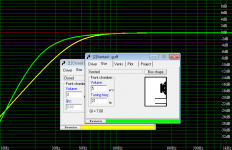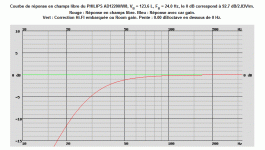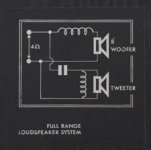Hi guys
I'm a bit of a newbie here and was wondering if some of you seasoned DIYers would be able to guide me in my quest to build a pair of subs. I have at my disposal a pair of Philips AD12200 12" LF drivers. I have googled them and come up with the following specs:
Fs 21Hz
Re 6,4ohm
Qes 0,328
Qms 4,062
Qts 0,304
Vas 287,4 ltr
Mms 70,4 g
Usable range is rated 20 - 1500 Hz.
Now, I need some advice on how best to mount these in some small enclosures, which would ideally sit 'neatly' below the lower mid section, which consists of a pair of old Klipsch Heresy cabs with just the 12" driver connected. If you could provide me with some dimensions and whether or not a port would be required, and if so what size.
The room is quite small measuring 14' x 15' approx, so want to try to avoid 'boom' if at all possible. Power is likely to be provided by a 50wpc solid state amp to begin with - would more grunt be beneficial? I listen to small scale Jazz and classical, some folk & blues, so the LF is purely for atmosphere and not 'slam'!
Thanks in advance for your thoughts
Inamelotone
I'm a bit of a newbie here and was wondering if some of you seasoned DIYers would be able to guide me in my quest to build a pair of subs. I have at my disposal a pair of Philips AD12200 12" LF drivers. I have googled them and come up with the following specs:
Fs 21Hz
Re 6,4ohm
Qes 0,328
Qms 4,062
Qts 0,304
Vas 287,4 ltr
Mms 70,4 g
Usable range is rated 20 - 1500 Hz.
Now, I need some advice on how best to mount these in some small enclosures, which would ideally sit 'neatly' below the lower mid section, which consists of a pair of old Klipsch Heresy cabs with just the 12" driver connected. If you could provide me with some dimensions and whether or not a port would be required, and if so what size.
The room is quite small measuring 14' x 15' approx, so want to try to avoid 'boom' if at all possible. Power is likely to be provided by a 50wpc solid state amp to begin with - would more grunt be beneficial? I listen to small scale Jazz and classical, some folk & blues, so the LF is purely for atmosphere and not 'slam'!
Thanks in advance for your thoughts
Inamelotone
"Small" and "good" sub do not match. First of all, download WinISL, the defacto standard box simulation. If you listen to Jazz, man you got to have solid clean bass. Not stupid movie effects, but real solid bass. Copland without a sub? Might as well listen to Debussy.
You don't "boom" by following the basic design guidelines for enclosure brought to us all by the good Mr. Thiel and Mr. Small. Please do some reading.
It is my preference for a sub to be in a sealed box with a Q in the .6 range. I find they blend into the room very well. I make use of boundary gain and get very pleasing balance into the low 20's. I have a disdain for ported subs. I would like to try an IB someday, but I bet the neighborhood would not.
For reference, my current subs are not unlike Linkwitz THOR subs. I use no eq at all. This driver is quite happy in a 60L box that will sit under a monitor.
A pair of 50W plates may work for music if you don't get carried away. It depends totally on the amp and if you are needing any eq. As I use none, I actually used a DH-220 for a while and it was OK. If you are going to do any eq, as in boost or a LT, well if 50W works with no eq, and you do 6 db boost, you need 200. If you put then next to each other, less power. I think it is a bit light if 4 Ohm drivers. My main system used a Parasound 1200 for the subs which blends well with the Rotel 951 I use for my mids. (I am not a big power fan, preferring lower distortion at typical output. Maybe this is because the cost of as bigger amp that is that good at higher power has not fallen into my lap. I just ordered an O-AUdio 500W plate so I will see how that does. It is replacing a 100W Rockford/Hafler plate in my guest room system.
You don't "boom" by following the basic design guidelines for enclosure brought to us all by the good Mr. Thiel and Mr. Small. Please do some reading.
It is my preference for a sub to be in a sealed box with a Q in the .6 range. I find they blend into the room very well. I make use of boundary gain and get very pleasing balance into the low 20's. I have a disdain for ported subs. I would like to try an IB someday, but I bet the neighborhood would not.
For reference, my current subs are not unlike Linkwitz THOR subs. I use no eq at all. This driver is quite happy in a 60L box that will sit under a monitor.
A pair of 50W plates may work for music if you don't get carried away. It depends totally on the amp and if you are needing any eq. As I use none, I actually used a DH-220 for a while and it was OK. If you are going to do any eq, as in boost or a LT, well if 50W works with no eq, and you do 6 db boost, you need 200. If you put then next to each other, less power. I think it is a bit light if 4 Ohm drivers. My main system used a Parasound 1200 for the subs which blends well with the Rotel 951 I use for my mids. (I am not a big power fan, preferring lower distortion at typical output. Maybe this is because the cost of as bigger amp that is that good at higher power has not fallen into my lap. I just ordered an O-AUdio 500W plate so I will see how that does. It is replacing a 100W Rockford/Hafler plate in my guest room system.
This driver PHILIPS AD12200/W8 was used in various kit forms (Philips catalog) in a sealed configuration from 80 L to 60 L (for the 4 Ohm version/W4). A new design from another forum, making use of one AD12200/W8 with an AD12100/M8 places it in a 50 L enclosure. The Philips catalogue (1980) mentions the use of a 80 L sealed enclosure with 0,5Kg of glass wool () damping material 430g back and side walls.
This driver has an EBP = 73.17 or = 64.02 considering either 24Hz (reference) or 21Hz (Fs) measured. Lower Fs makes it better for a sealed enclosure.
The best performance is achieved placing the driver in a BR, with 124 L/4.37 cu ft:
PHILIPS AD12200W8, VB = 123.6 L, FB = 24.0 Hz, 92.7 dB2.83Vm.
F3=36 Hz, F6=27 Hz, F12=20 Hz (05.2012/inductor)
This driver has an EBP = 73.17 or = 64.02 considering either 24Hz (reference) or 21Hz (Fs) measured. Lower Fs makes it better for a sealed enclosure.
The best performance is achieved placing the driver in a BR, with 124 L/4.37 cu ft:
PHILIPS AD12200W8, VB = 123.6 L, FB = 24.0 Hz, 92.7 dB2.83Vm.
F3=36 Hz, F6=27 Hz, F12=20 Hz (05.2012/inductor)

Attachments
Hi
Thank you all for your suggestions - I favour sealed enclosures too so will look at that option. I should be able to manage 50l a side volume-wise, if I go for a slightly deeper footprint, but will look up the simulation software to try and work out the optimum dimensions.
Also for info, crossover between LF and lower-mid will be 24db/oct, courtesy of an old Lab Gruppen electronic crossover, and 80Hz is pretty much what I had in mind.
So all in all it looks quite promising... thanks again!

Thank you all for your suggestions - I favour sealed enclosures too so will look at that option. I should be able to manage 50l a side volume-wise, if I go for a slightly deeper footprint, but will look up the simulation software to try and work out the optimum dimensions.
Also for info, crossover between LF and lower-mid will be 24db/oct, courtesy of an old Lab Gruppen electronic crossover, and 80Hz is pretty much what I had in mind.
So all in all it looks quite promising... thanks again!
Philips
Hello everybody,
I am planning to build a subwoofer for Philips 22RH453.
I have ordered the Hp today. They are MIVOC aw3000. I will probably use them in vented 80L f328Hz. I was interested in 4th band by pass but some expert told me I need a cross over even with that. I don't have any method for calculating a 6th order, but would be very interested to have some link. WinIsd doesn't automaticaly calculate the box dim, and it seems difficult to do that.
Here is a link for my actual project :
3 voies à base de Philips 22RH453 (medium 8066 w4)
I will also probably try to find this Philips 12" because I like very much this type of vintage drivers.
Did You finaly build this sub ?
cheers and happy new years all
Hello everybody,
I am planning to build a subwoofer for Philips 22RH453.
I have ordered the Hp today. They are MIVOC aw3000. I will probably use them in vented 80L f328Hz. I was interested in 4th band by pass but some expert told me I need a cross over even with that. I don't have any method for calculating a 6th order, but would be very interested to have some link. WinIsd doesn't automaticaly calculate the box dim, and it seems difficult to do that.
Here is a link for my actual project :
3 voies à base de Philips 22RH453 (medium 8066 w4)
I will also probably try to find this Philips 12" because I like very much this type of vintage drivers.
Did You finaly build this sub ?
cheers and happy new years all
received the speakers
i have received the speakers : MIVOC AW3000
I have also ordered and received to amplifiers for subwoofers filtered at 60 to 160Hz
I would like to designed the boxes now. Probably vented. The best simulation I made is with 76L at f3=28Hz on boxsim.
Do You think it would be good ? some people think it is to big.
i have received the speakers : MIVOC AW3000
I have also ordered and received to amplifiers for subwoofers filtered at 60 to 160Hz
I would like to designed the boxes now. Probably vented. The best simulation I made is with 76L at f3=28Hz on boxsim.
Do You think it would be good ? some people think it is to big.
Do You think it would be good ? some people think it is to big.
I use it in closed
3way, classic monitor design
Too big (for an optimized BR).The best simulation I made is with 76L at f3=28Hz on boxsim.
Do You think it would be good ? some people think it is to big.
Ok, so we have now MIVOC AW 3000.
I love sealed speakers. In this case I would go with MIVOC in a BR VB = 40/45 L, FB = 28 Hz. Sealed it's possible but, and if VB = 76 L, F5 in the 50's (Hz) vs. BR F5 in the 30's (Hz).
Philips AD0161 25mm, dome tweeter
Philips AD8066/W4 200mm
MIVOC AW 3000
(Philips 22RH453 original crossover)
Attachments
Last edited:
I have also bought subwoofer crossed amplified modules. On theses modules I can adjust cross frequency from 40 to 160 Hz, phase switch and Power level on the Woofer. I have bought 2 of this amp, because I don't want to make a single subwoofer, but two of them as Sub enclosers on for each Philips speaker, placed on the ground as bases.
I would like to build soon these cabs. So I need now to make the woodworking and vents plan. I am not against volume of 64L f3 34Hz, as some people recommend me. But in boxsim, with active or passive filter, when I grow up a little the volume and decrease the f3 ( 76L 28Hz ) I can reach some 30Hz with -3dB. So what has to be choosen now ? I am now hesitating...
Modeling for an active is going to be different from a passive loudspeaker. Mostly because you don't want a knee in the low frequency roll-off of the loudspeaker. With DSP and active crossover/amp where you have some active control in the lower frequencies it's different. Usually I don't model in a simulator this type of setup, others do, but a BR looks more favorable than a sealed enclosure. You can also test this closing the port. The box you mention it's more favorable to a sub and it's a long away from the 40 L optimized (passive) for this driver. MIVOC AW 3000
The freq. you mention of 30Hz is a free field measurement/simulation and you will have ~26Hz inside the room. So that's why a lot of maximized low-frequencies will give you a peak in the room where room properties typically dominate the rate of energy decay. I would go for the purpose of testing with the 60'sL in room as you mention and 50'sL for a better integration and better smooth roll-off. That's why also not bad idea to test a sealed one with good integration.
F3 in a sealed enclosure is going to be in the high's 70'sHz what might not be enough/advisable for a sub.
The freq. you mention of 30Hz is a free field measurement/simulation and you will have ~26Hz inside the room. So that's why a lot of maximized low-frequencies will give you a peak in the room where room properties typically dominate the rate of energy decay. I would go for the purpose of testing with the 60'sL in room as you mention and 50'sL for a better integration and better smooth roll-off. That's why also not bad idea to test a sealed one with good integration.
F3 in a sealed enclosure is going to be in the high's 70'sHz what might not be enough/advisable for a sub.
Last edited:
someone in another thread of this forum tells the MIVOC aw3000 must be used in sealed enclosure... what to think about that?
Anyway, what would be the best volume to use ? does it depend to the filter ? mine is active amp crossed at 160Hz
Hi,
Someone must be joking.
http://www.diyaudio.com/forums/subwoofers/201984-design-check-simple-100-sub.html
b
- Status
- This old topic is closed. If you want to reopen this topic, contact a moderator using the "Report Post" button.
- Home
- Loudspeakers
- Multi-Way
- Advice needed for sub enclosures


